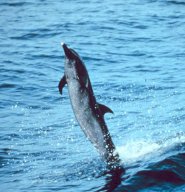 The pantropical spotted dolphin (Stenella attenuata) is a species of dolphin in the genus Stenella and is one of the more distinctive species of dolphin in the world's oceans. When the pantropical spotted dolphin is born it can be hard to distinguish it from its cousin the common bottlenose dolphin as they are without spots. The dolphin acquires spots as it matures until the body is eventually covered with overlapping patterns of spots. When the pantropical spotted dolphin reaches maturity the body has a distinct black "cape" down its back with gray along the sides and a white underbelly. The pantropical spotted dolphin, like many of the other species in the Stenella genus, is a smaller dolphin. The average dolphin grows to between 1.5-2 meters (6-7ft) in length and weighs around 114 kg (250lbs).
The pantropical spotted dolphin (Stenella attenuata) is a species of dolphin in the genus Stenella and is one of the more distinctive species of dolphin in the world's oceans. When the pantropical spotted dolphin is born it can be hard to distinguish it from its cousin the common bottlenose dolphin as they are without spots. The dolphin acquires spots as it matures until the body is eventually covered with overlapping patterns of spots. When the pantropical spotted dolphin reaches maturity the body has a distinct black "cape" down its back with gray along the sides and a white underbelly. The pantropical spotted dolphin, like many of the other species in the Stenella genus, is a smaller dolphin. The average dolphin grows to between 1.5-2 meters (6-7ft) in length and weighs around 114 kg (250lbs).It is possible to mistake the pantropical spotted dolphin with the coastal spotted dolphin and Atlantic spotted dolphin. However, the coastal dolphin is a subspecies of the pantropical spotted dolphin while the Atlantic dolphin is a different species in the Stenella genus. It is often hard to differentiate between the varieties as their coloration is very similar, but the pantropical spotted dolphin is often slightly smaller at full maturity and is found in a wider stretch of ocean.
The pantropical spotted dolphin is unique for its unexplained association with yellow fin tuna. In fact, the species gained international notoriety in the late 1970s and 1980s as the species was pushed to the brink of annihilation due to their association with the yellow fin tuna. As fishermen around the globe used purse-seine nets to trap the tuna, they would trap the dolphins in their nets as well, leading to suffocation of the dolphins. An intense focus on dolphin-safe tuna fishing standards in the United States has helped bring the pantropical spotted dolphins' numbers back up, but its association with the yellow fin tuna and questionable fishing habits by mankind remain the biggest threats to the pantropical spotted dolphin.
The Bridled dolphin, narrow-snouted dolphin, pantropical spotted dolphin is listed as Conservation Dependent (LR/cd), the focus of a continuing taxon-specific or habitat-specific conservation programme targeted towards the taxon in question, the cessation of which would result in the taxon qualifying for one of the threatened categories below within a period of five years, on the IUCN Red List of Threatened Species
Namings for the pantropical spotted dolphin
A young / baby of a pantropical spotted dolphin is called a 'calf or pup'. The females are called 'cow' and males 'bull'. A pantropical spotted dolphin group is called a 'team, school, pod, herd, alliance (male) or party (female)'.Countries
Argentina, Australia, Brazil, Burma, Cape Verde, China, Costa Rica, Djibouti, Fiji, Gabon, Honduras, India, Indonesia, Japan, Kenya, Korea, North, Korea, South, Madagascar, Malaysia, Maldives, Mexico, New Zealand, Oman, Panama, Papua New Guinea, Peru, Philippines, Saint Helena, Saint Vincent and the Grenadines, Seychelles, Singapore, Solomon Islands, South Africa, Sri Lanka, Taiwan, Tanzania, Thailand, Tuvalu, United States, Uruguay and VanuatuSome facts about the
Pantropical spotted dolphin
Adult weight : 112.5 kg (247.5 lbs)
Maximum longevity : 46 years
Female maturity :2983 days
Male maturity : 3956 days
Gestation : 345 days
Weaning : 543 days
Litter size : 1
Interval between litters : 1123 days
Weight at birth : 10 kg (22 lbs)

Custom Search